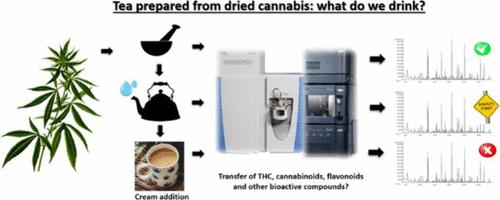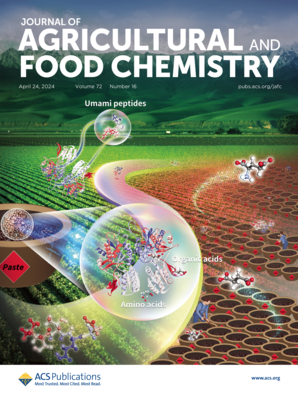用干大麻制茶:我们喝什么?
IF 5.7
1区 农林科学
Q1 AGRICULTURE, MULTIDISCIPLINARY
引用次数: 0
摘要
除了许多其他用途外,干大麻还可用于制备 "茶"。这项研究的重点是全面分析按照常见做法从三个相当不同的大麻品种中制备的水浸液的特征。研究采用超高效液相色谱-质谱法(UHPLC-HRMS/MS)对 42 种植物大麻素和 12 种主要生物活性化合物(类黄酮)转移到输液中的情况进行了调查。与同类物质相比,植物大麻素酸的转移程度普遍较高;就Δ9-THC 而言,其在所用大麻中的含量仅为 0.4-1.9% 之间。如果在浸泡过程中加入奶油,植物大麻素(主要是中性植物大麻素)的含量会急剧增加,Δ9-THC 在 "茶 "中的转移率达到 53-64%。在这种情况下,一个体重 70 千克的人饮用一杯 250 毫升的这种茶可能会导致多次超过急性参考剂量(ARfD),即 1 微克/千克体重,即使在使用Δ9-THC 含量低于 1%(干重)的大麻进行制备的情况下也是如此。本文章由计算机程序翻译,如有差异,请以英文原文为准。

Tea Prepared from Dried Cannabis: What Do We Drink?
Besides many other uses, dried Cannabis may be used for “tea” preparation. This study focused on a comprehensive characterization of an aqueous infusion prepared according to a common practice from three fairly different Cannabis cultivars. The transfer of 42 phytocannabinoids and 12 major bioactive compounds (flavonoids) into the infusion was investigated using UHPLC-HRMS/MS. Phytocannabinoid acids were transferred generally in a higher extent compared to their counterparts; in the case of Δ9-THC, it was only in the range of 0.4–1.9% of content in the Cannabis used. A dramatic increase of phytocannabinoids, mainly of the neutral species, occurred when cream was added during steeping, and the transfer of Δ9-THC into “tea” achieved a range of 53–64%. Under such conditions, drinking a 250 mL cup of such tea by a 70 kg person might lead to multiple exceedance of the Acute Reference Dose (ARfD), 1 μg/kg b.w., even in the case when using hemp with a Δ9-THC content below 1% in dry weight for preparation.
求助全文
通过发布文献求助,成功后即可免费获取论文全文。
去求助
来源期刊
CiteScore
9.90
自引率
8.20%
发文量
1375
审稿时长
2.3 months
期刊介绍:
The Journal of Agricultural and Food Chemistry publishes high-quality, cutting edge original research representing complete studies and research advances dealing with the chemistry and biochemistry of agriculture and food. The Journal also encourages papers with chemistry and/or biochemistry as a major component combined with biological/sensory/nutritional/toxicological evaluation related to agriculture and/or food.

 求助内容:
求助内容: 应助结果提醒方式:
应助结果提醒方式:


